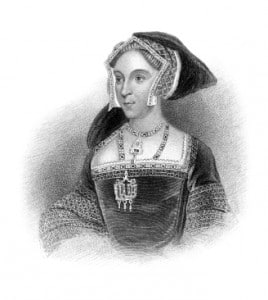 At 9am on 20th May 1536, the day after his second wife had been executed, Henry VIII became betrothed to Jane Seymour, daughter of Sir John Seymour and Margery Wentworth. Their betrothal was meant to be kept secret but Chapuys recorded that the news got out:
At 9am on 20th May 1536, the day after his second wife had been executed, Henry VIII became betrothed to Jane Seymour, daughter of Sir John Seymour and Margery Wentworth. Their betrothal was meant to be kept secret but Chapuys recorded that the news got out:
“everybody begins already to murmur by suspicion, and several affirm that long before the death of the other there was some arrangement which sounds ill in the ears of the people…”1
Jane is first mentioned in the primary sources, in relation to Henry VIII showing an interest in her, on 10th February 1536 in a letter from Eustace Chapuys, the imperial ambassador, to Emperor Charles V. In the letter, Chapuys was pondering the reasons for Anne Boleyn’s recent miscarriage (on 29th January) and one reason he gave was the King giving Jane Seymour “great presents”.2 The King’s interest in Jane, therefore, dated back to at least January 1536 but may simply have been a courtly love flirtation while Anne was pregnant.
On 18th March 1536, Edward Seymour, Jane’s brother, was appointed to Henry VIII’s Privy Chamber “to the intense rage of the concubine”,3, and then on 1st April 1536 Henry VIII sent Jane a gift. Chapuys wrote of how he’d heard that the King had sent Jane “a purse full of sovereigns” and that on receiving the purse, Jane had kissed the letter and begged the messenger to tell the King that she could not take the purse because “she was a gentlewoman of good and honorable parents, without reproach, and that she had no greater riches in the world than her honor, which she would not injure for a thousand deaths, and that if he wished to make her some present in money she begged it might be when God enabled her to make some honorable match.”4 According to Chapuys, Jane was being coached by Sir Nicholas Carew and the Catholic faction in how to appeal to the King and also to tell him how much the people of England “detested” his marriage to Anne Boleyn.
On 14th May 1536, while Anne Boleyn was imprisoned in the Tower of London, Henry VIII sent Sir Nicholas Carew to fetch Jane Seymour and to install her in a house in Chelsea, within a mile of the King’s own lodgings. Chapuys recorded that Jane was “most richly dressed” and “splendidly served by the King’s cook and other officers”,5 so, like Anne before her, she was being treated as the Queen-in-waiting while Henry got rid of his previous wife.
At some point between Jane’s arrival at Chelsea and Anne Boleyn’s execution, Henry VIII wrote to Jane regarding some pamphlets which were being spread around London deriding their relationship, so gossip about their relationship was obviously spreading. On the morning of Anne’s trial, Henry VIII arranged with Jane’s household that he would send “news at 3 o’clock of the condemnation of the putain”,6 so he was obviously sure that Anne would be condemned. Following Anne’s beheading, “the King, immediately on receiving news of the decapitation of the putain entered his barge and went to the said Semel [Jane Seymour], whom he has lodged a mile from him, in a house by the river.” Henry was not wasting any time, he wanted to move on with his life and marry a woman who could provide him with a son and heir. His betrothal to Jane on 20th May was followed by their marriage on 30th May.
Henry VIII’s courtship of Jane Seymour sounds distasteful to us today, and it is easy to paint Jane Seymour as a woman who danced on the grave of Anne Boleyn, but it is impossible to know what Jane thought about the events of May 1536. Chapuys tells us that Jane was coached in how to appeal to the King but we don’t know whether she was a puppet or whether she enticed the King willingly. Whatever her own private thoughts, once the King had chosen her as his consort she had to get on with things and be the best queen that she could be.
Notes and Sources
- LP x. 926
- Ibid., 282
- Ibid., 495
- Calendar of State Papers, Spain, Volume 5 Part 2: 1536-1538, note 43
- LP x. 908
- Ibid.